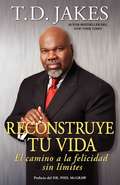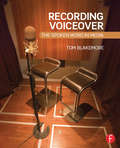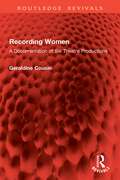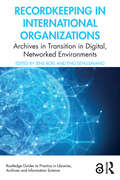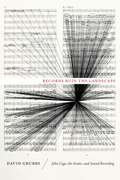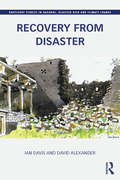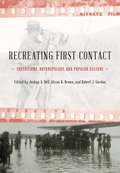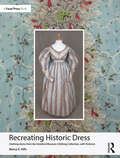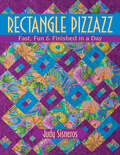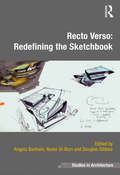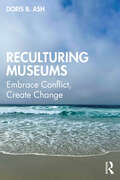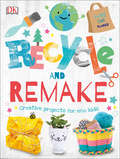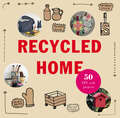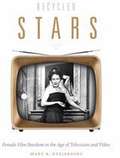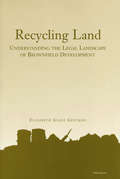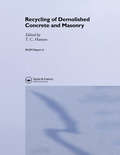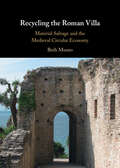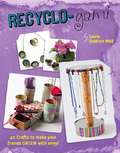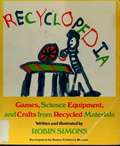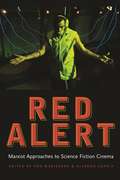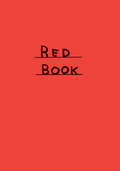- Table View
- List View
Reconstruye tu vida (Reposition Yourself)
by T. D. JakesEn su œltimo libro, Reconstruye tu vida, el exitoso autor T.D. Jakes brinda consejos que ayudar n a los lectores a ajustarse a los muchos cambios que la vida trae. ƒste es un llamado a despertar y hacerte cargo de tu vida ÁAhora! Este libro no s--lo aborda las zonas donde la pasividad o incluso las decisiones torpes han ahogado la creatividad del lector, sino que tambiŽn instruye sobre la manera de controlar los cambios y sacarle el m ximo de provecho a la vida. ValiŽndose del conocimiento adquirido en m s de treinta a-os de ejercer la consejer'a y de trabajar tanto con personas ordinarias como con destacadas personalidades, Jakes abarca la creatividad econ--mica, relacional y espiritual y muestra c--mo el adaptarse a momentos de transici--n en la vida es el camino para una existencia llena de satisfacci--n en todas sus etapas. Reconstruye tu vida ofrece planes concretos para aquellos que aspiran a un futuro m s productivo. Jakes acepta la inevitabilidad del cambio, te ense-a c--mo esperarlo y asumirlo en lugar de temerle. Mezclando conocimientos religiosos y seculares, comparte una combinaci--n singular de f--rmulas pr cticas y pragm ticas pareja a la sabidur'a de la Escritura por la que Žl se destaca. Este libro es sin duda una restauraci--n para el alma. Te capacita para tener Žxito y te ofrece los instrumentos necesarios para alcanzar las ilimitadas posibilidades que resultan de hacer peque-os ajustes en tus ideas y planes. Jakes cree que no hay nada m s importante que la pr--xima decisi--n que vayas a tomar. Antes de hacer otra elecci--n, ÁŽsta es una lectura obligada!
Recording Voiceover: The Spoken Word in Media
by Tom BlakemoreThe only book on the market to specifically address its audience, Recording Voiceover is the comprehensive guide for engineers looking to understand the aspects of capturing the spoken word. Discussing all phases of the recording session, Recording Voiceover addresses everything from microphone recommendations for voice recording to pre-production considerations, including setting up the studio, working with and directing the voice talent, and strategies for reducing or eliminating distracting noise elements found in human speech. Recording Voiceover features in-depth, specific recommendations for recording radio and television commercials, corporate communications, documentaries, tracks for gaming and animation, radio drama, interviews and roundtable discussions. A discussion of the voice in film and television is also included. Special attention is paid to the final release format and its impact on recording strategies. Exploration of using telephone interfaces – including both analogue and digital ISDN, as well as recording across the internet – is included.
Recording Women: A Documentation of Six Theatre Productions (Routledge Revivals)
by Geraldine CousinFirst Published in 2000, Recording Women documents the work of three leading feminist theatre companies, Sphinx Theatre Company, Scarlett Theatre and Foresight Theatre, through a combination of interviews with theatre practitioners and detailed descriptions of productions in performance. Each of the six productions is innovative in content and style.Scarlett Theatre’s Paper Walls and Foresight Theatre’s Boadicea: The Red-Bellied Queen employ a skillful mixture of text, music, physical performance, humour and seriousness to explore, respectively, domestic abuse and rape (of women and community). Scarlett Theatre’s The Sisters and Sphinx’s Voyage in the Dark adapt existing texts. The sisters is a ritualized re-enactment of Chekhov’s Three Sisters in which only the female characters from the play appear. Voyage in the Dark uses film-noir-like theatrical effects and the insistent rhythms of the tango to evoke the rootlessness and sense of alienation that characterizes Jean Rhys’s novel. Slap (Foursight Theatre) and Goliath (Sphinx) are both one woman shows. Slap, performed by Naomi Cooke, explores images of motherhood, including lesbian motherhood and the concept of virgin birth. Goliath, performed by Nicola McAuliffe, is a dramatization, by Bryony Lavery, of Beatrix Campbell’s powerful study of the 1991 riots in Cardiff, Oxford and Tyneside. This is a must read for scholars and researchers of theatre studies.
Recordkeeping in International Organizations: Archives in Transition in Digital, Networked Environments (Routledge Guides to Practice in Libraries, Archives and Information Science)
by Jens Boel Eng SengsavangRecordkeeping in International Organizations offers an important treatment of international organizations from a recordkeeping perspective, while also illustrating how recordkeeping can play a vital role in our efforts to improve global social conditions.Demonstrating that organizations have both a responsibility and an incentive to effectively manage their records in order to make informed decisions, remain accountable to stakeholders, and preserve institutional history, the book offers practical insights and critical reflections on the effective management, protection, and archiving of records. Through policy advice, surveys, mind mapping, case studies, and strategic reflections, the book provides guidance in the areas of archives, records, and information management for the future. Among the topics addressed are educational requirements for recordkeeping professionals, communication policies, data protection and privacy, cloud computing, classification and declassification policies, artificial intelligence, risk management, enterprise architecture, and the concepts of extraterritoriality and inviolability of archives. The book also offers perspectives on how digital recordkeeping can support the UN’s 2030 Agenda for Sustainable Development, and the accompanying Sustainable Development Goals (SDGs).Recordkeeping in International Organizations will be essential reading for records and archives professionals, information technology, legal, security, management, and leadership staff, including chief information officers. The book should also be of interest to students and scholars engaged in the study of records, archives, and information management, information technology, information security, and law.Chapters 7 and 9 of this book are freely available as a downloadable Open Access PDF at http://www.taylorfrancis.com under a Attribution-NonCommercial-ShareAlike (CC-BY-NC-SA) 4.0 license
Recordkeeping in International Organizations: Archives in Transition in Digital, Networked Environments (Routledge Guides to Practice in Libraries, Archives and Information Science)
by Jens Boel and Eng SengsavangRecordkeeping in International Organizations offers an important treatment of international organizations from a recordkeeping perspective, while also illustrating how recordkeeping can play a vital role in our efforts to improve global social conditions. Demonstrating that organizations have both a responsibility and an incentive to effectively manage their records in order to make informed decisions, remain accountable to stakeholders, and preserve institutional history, the book offers practical insights and critical reflections on the effective management, protection, and archiving of records. Through policy advice, surveys, mind mapping, case studies, and strategic reflections, the book provides guidance in the areas of archives, records, and information management for the future. Among the topics addressed are educational requirements for recordkeeping professionals, communication policies, data protection and privacy, cloud computing, classification and declassification policies, artificial intelligence, risk management, enterprise architecture, and the concepts of extraterritoriality and inviolability of archives. The book also offers perspectives on how digital recordkeeping can support the UN’s 2030 Agenda for Sustainable Development, and the accompanying Sustainable Development Goals (SDGs). Recordkeeping in International Organizations will be essential reading for records and archives professionals, information technology, legal, security, management, and leadership staff, including chief information officers. The book should also be of interest to students and scholars engaged in the study of records, archives, and information management, information technology, information security, and law.
Records Ruin the Landscape: John Cage, the Sixties, and Sound Recording
by David GrubbsJohn Cage's disdain for records was legendary. He repeatedly spoke of the ways in which recorded music was antithetical to his work. In Records Ruin the Landscape, David Grubbs argues that, following Cage, new genres in experimental and avant-garde music in the 1960s were particularly ill suited to be represented in the form of a recording. These activities include indeterminate music, long-duration minimalism, text scores, happenings, live electronic music, free jazz, and free improvisation. How could these proudly evanescent performance practices have been adequately represented on an LP?In their day, few of these works circulated in recorded form. By contrast, contemporary listeners can encounter this music not only through a flood of LP and CD releases of archival recordings but also in even greater volume through Internet file sharing and online resources. Present-day listeners are coming to know that era's experimental music through the recorded artifacts of composers and musicians who largely disavowed recordings. In Records Ruin the Landscape, Grubbs surveys a musical landscape marked by altered listening practices.
Recovery from Disaster (Routledge Studies in Hazards, Disaster Risk and Climate Change)
by David Alexander Ian DavisDisasters can dominate newspaper headlines and fill our TV screens with relief appeals, but the complex long-term challenge of recovery—providing shelter, rebuilding safe dwellings, restoring livelihoods and shattered lives—generally fails to attract the attention of the public and most agencies. On average 650 disasters occur each year. They affect more than 200 million people and cause $166 trillion of damage. Climate change, population growth and urbanisation are likely to intensify further the impact of natural disasters and add to reconstruction needs. Recovery from Disaster explores the field and provides a concise, comprehensive source of knowledge for academics, planners, architects, engineers, construction managers, relief and development officials and reconstruction planners involved with all sectors of recovery, including shelter and rebuilding. With almost 80 years of first-hand experience of disaster recovery between them, Ian Davis (an architect) and David Alexander (a geographer) draw substantially from first-hand experiences in a variety of recovery situations in China, Haiti, Italy, Japan, New Zealand, Pakistan, the Philippines and the USA. The volume is further enriched by two important and unique features: 21 models of disaster recovery are presented, seven of which were specifically developed for the book. The second feature is a survey of expert opinion about the nature of effective disaster recovery—the first of its kind. More than 50 responses are provided in full, along with an analysis that integrates them with the theories that underpin them. By providing a framework and models for future study and applications, Davis and Alexander seek both to advance the field and to provide a much-needed reference work for decision makers. With a broad perspective derived from the authors' roles held as university professors, researchers, trainers, consultants, NGO directors and advisors to governments and UN agencies, this comprehensive guide will be invaluable for practitioners and students of disaster management.
Recreating First Contact: Expeditions, Anthropology, and Popular Culture
by Joshua A. Bell Alison K. Brown Robert J. GordonRecreating First Contact explores themes related to the proliferation of adventure travel which emerged during the early twentieth century and that were legitimized by their associations with popular views of anthropology. During this period, new transport and recording technologies, particularly the airplane and automobile and small, portable, still and motion-picture cameras, were utilized by a variety of expeditions to document the last untouched places of the globe and bring them home to eager audiences. These expeditions were frequently presented as first contact encounters and enchanted popular imagination. The various narratives encoded in the articles, books, films, exhibitions and lecture tours that these expeditions generated fed into pre-existing stereotypes about racial and technological difference, and helped to create them anew in popular culture. Through an unpacking of expeditions and their popular wakes, the essays (12 chapters, a preface, introduction and afterward) trace the complex but obscured relationships between anthropology, adventure travel and the cinematic imagination that the 1920s and 1930s engendered and how their myths have endured. The book further explores the effects - both positive and negative - of such expeditions on the discipline of anthropology itself. However, in doing so, this volume examines these impacts from a variety of national perspectives and thus through these different vantage points creates a more nuanced perspective on how expeditions were at once a global phenomenon but also culturally ordered.
Recreating Historic Dress: Clothing Gems from the Hereford Museum Clothing Collection, with Patterns
by Nancy E. HillsRecreating Historic Dress: Clothing Gems from the Hereford Museum Clothing Collection, with Patterns compiles patterns and information for 25 never-before-published garments from the historic clothing collection at the Hereford Museum and Art Gallery Resource Centre, Hereford, UK.An accurate study of dress is dependent on the very close and careful examination of existing garments. Nancy Hills has conducted a detailed analysis of a range of garments, spanning the years 1755 through to 1954, carefully exploring what they can tell us and translating them into paper patterns. Each featured garment contains a detailed description, the pattern, historical context, and images of the full article of clothing and construction details from inside the garment. This book features an eclectic selection of clothing, including a comfortable 18th-century cotton caraco often worn for work, leisure, travel, or pregnancy, a simple cotton print dress worn in 1834 as a wedding dress, and two dresses, one from 1936 and one from 1954, that show a more elite pedigree, with their labels of popular London designers.This book will be of interest to experienced costume designers and technicians, cutters and drapers, intermediate students of theatrical costume design, and historical reenactors.
Recreational Land Management
by C.W.N. Miles Professor C Miles W. SeabrookeThe aim of this book is to construct a framework of understanding for those coming to the field of recreational land management from a non-land management discipline.
Rectangle Pizzazz: Fast, Fun & Finished in a Day
by Judy SisnerosA beginner book without that &“beginner look&” from the author of 9-Patch Pizzazz. You&’ll get addicted to the &“potato chip quilt&”—no one can make just one. Make easy, colorful quilts from the simplest shape and using your favorite fabrics, including large-scale, novelty, and panels. Talk about bang for the buck: combining a special fabric with a few easy nine-patches yields captivating quilts ranging from sassy to sophisticated. You&’ll get hooked on this technique! Judy provides sixteen different layouts for unlimited project potential. - Five quilts—each easy enough to put together in a day, even for beginners - Simple construction plus fabulous fabrics yields dramatic quilts - The perfect use for those big beautiful prints you love too much to cut Easy designs and fast strip piecing make these quilts come together in no time!
Recto Verso: Redefining The Sketchbook
by Angela Bartram Nader El-Bizri Douglas GittensBringing together a broad range of contributors including art, architecture, and design academic theorists and historians, in addition to practicing artists, architects, and designers, this volume explores the place of the sketchbook in contemporary art and architecture. Drawing upon a diverse range of theories, practices, and reflections common to the contemporary conceptualisation of the sketchbook and its associated environments, it offers a dialogue in which the sketchbook can be understood as a pivotal working tool that contributes to the creative process and the formulation and production of visual ideas. Along with exploring the theoretical, philosophical, psychological, and curatorial implications of the sketchbook, the book addresses emergent digital practices by way of examining contemporary developments in sketchbook productions and pedagogical applications. Consequently, these more recent developments question the validity of the sketchbook as both an instrument of practice and creativity, and as an educational device. International in scope, it not only explores European intellectual and artistic traditions, but also intercultural and cross-cultural perspectives, including reviews of practices in Chinese artworks or Islamic calligraphy, and situational contexts that deal with historical examples, such as Roman art, or modern practices in geographical-cultural regions like Pakistan.
Reculturing Museums: Embrace Conflict, Create Change
by Doris B. AshReculturing Museums takes a unified sociocultural theoretical approach to analyze the many conflicts museums experience in the 21st century. Embracing conflict, Ash asks: What can practitioners and researchers do to create the change they want to see when old systems remain stubbornly in place? Using a unified sociocultural, cultural-historical, activity-theoretical approach to analyzing historically bound conflicts that plague museums, each chapter is organized around a central contradiction, including finances ("Who will pay for museums?"), demographic shifts ("Who will come to museums?"), the roles of narratives ("Whose story is it?"), ownership of objects ("Who owns the artifact?"), and learning and teaching ("What is learning and how can we teach equitably?"). The reculturing stance taken by Ash promotes social justice and equity, ‘making change’ first, within museums, called inreach, rather than outside the museum, called outreach; challenges existing norms; is sensitive to neoliberal and deficit ideologies; and pays attention to the structure agency dialectic. Reculturing Museums will be essential reading for academics, students, museum practitioners, educational researchers, and others who care about museums and want to ensure that all people have equal access to the activities, objects, and ideas residing in them.
Reculturing Museums: Embrace Conflict, Create Change
by Doris B. AshReculturing Museums takes a unified sociocultural theoretical approach to analyze the many conflicts museums experience in the 21st century. Embracing conflict, Ash asks: What can practitioners and researchers do to create the change they want to see when old systems remain stubbornly in place?Using a unified sociocultural, cultural-historical, activity-theoretical approach to analyzing historically bound conflicts that plague museums, each chapter is organized around a central contradiction, including finances ("Who will pay for museums?"), demographic shifts ("Who will come to museums?"), the roles of narratives ("Whose story is it?"), ownership of objects ("Who owns the artifact?"), and learning and teaching ("What is learning and how can we teach equitably?"). The reculturing stance taken by Ash promotes social justice and equity, ‘making change’ first, within museums, called inreach, rather than outside the museum, called outreach; challenges existing norms; is sensitive to neoliberal and deficit ideologies; and pays attention to the structure agency dialectic.Reculturing Museums will be essential reading for academics, students, museum practitioners, educational researchers, and others who care about museums and want to ensure that all people have equal access to the activities, objects, and ideas residing in them.
Recycle and Remake: Creative Projects for Eco Kids
by DKKids are on a mission to save the Earth! Recycle and Remake is the hands-on, practical guide they need to get started.This gentle, but empowering book is full of creative making activities, information, and ideas that give young eco-warriors the know-how to really help the environment. With Recycle and Remake, kids will soon be saving trees by making their own seeded recycled paper from junk mail, cleaning up the oceans by turning old shopping bags into kites, friendship bracelets, and colorful woven baskets, and repurposing a cardboard box into a periscope. They'll also learn about sustainable energies by creating a simple solar oven, cutting down on plastic wrap by making a food wrap from scrap cotton and beeswax, and turning an old tee shirt into a reusable tote bag. They can even grow new plants to clean the air in their own upcycled milk bottle planters and using homemade compost.As kids make and create, they will learn kid-friendly facts about the big issues our planet is facing. Each of the activities directly relates to an environmental hot topic, such as plastic pollution, food waste, or deforestation. Budding environmentalists all over the world are feeling inspired to do their part for our amazing planet. This future-friendly book is here to guide them with all the information, ideas, tips, and tools they need to be part of the solution.
Recycled Home: Transform Your Home Using Salvaged Materials
by Rebecca ProctorRecycled Home features 50 stylish craft projects for the home, using discarded or repurposed materials. Step-by-step illustrations guide you through each project, and no special skills are needed. From quick fixes taking half an hour to a patchwork throw to spend a weekend on, you'll find something to inspire you.With chapters covering every room, the book features everything from making cushions and bedlinen to turning an old crate into a bathroom cabinet or constructing your own garden teepee. The wide range of projects means that there is something for every taste, budget and skill level. Update your home creatively and economically with flair and style. Recycled Home will appeal to those interested in interiors, textiles, craft, gardening and sustainability.
Recycled Home: Transform Your Home Using Salvaged Materials
by Rebecca ProctorRecycled Home features 50 stylish craft projects for the home, using discarded or repurposed materials. Step-by-step illustrations guide you through each project, and no special skills are needed. From quick fixes taking half an hour to a patchwork throw to spend a weekend on, you'll find something to inspire you.With chapters covering every room, the book features everything from making cushions and bedlinen to turning an old crate into a bathroom cabinet or constructing your own garden teepee. The wide range of projects means that there is something for every taste, budget and skill level. Update your home creatively and economically with flair and style. Recycled Home will appeal to those interested in interiors, textiles, craft, gardening and sustainability.
Recycled Stars: Female Film Stardom in the Age of Television and Video
by Mary R. DesjardinsThe popularity of television in postwar suburban America had a devastating effect on the traditional Hollywood studio system. Yet many aging Hollywood stars used television to revive their fading careers. In Recycled Stars, Mary R. Desjardins examines the recirculation, ownership, and control of female film stars and their images in television, print, and new media. Female stardom, she argues, is central to understanding both the anxieties and the pleasures that these figures evoke in their audiences' psyches through patterns of fame, decline, and return. From Gloria Swanson, Loretta Young, Ida Lupino, and Lucille Ball, who found new careers in early television, to Maureen O'Hara's high-profile 1957 lawsuit against the scandal magazine Confidential, to the reappropriation of iconic star images by experimental filmmakers, video artists, and fans, this book explores the contours of female stars' resilience as they struggled to create new contexts for their waning images across emerging media.
Recycling Land: Understanding the Legal Landscape of Brownfield Development
by Elizabeth Glass GeltmanOlder--and often economically depressed--industrial cities generally have a number of well located but abandoned industrial sites. Too frequently these sites are heavily polluted by the residue of toxic wastes dumped when old factories were still in use. These "brownfield" sites must be cleaned up under existing law before they can be redeveloped. And yet the question of who will bear the cost of this cleanup frequently stymies efforts to return these sites to productive use. A complicated net of federal, state and local regulations can involve several generations of owners in potential liability for the cleanup, frequently resulting only in extended litigation, not often in the cleanup of the site. In this book, Elizabeth Glass Geltman surveys the laws on both the federal and state level with regard to the cleanup of brownfield sites. The author makes valuable suggestions for reforming these laws that will help encourage land reuse and the accompanying redevelopment of the industrial base of many American cities both large and small. Elizabeth Glass Geltman is Professor of Law, George Washington University Law School and is the author of many books on environmental law, includingModern Environmental Law: Policy and Practice.
Recycling of Demolished Concrete and Masonry
by T. C. HansenThis new RILEM report contains state-of-the-art reviews on three topics: recycling of demolished concrete, recycling of masonry rubble and localized cutting by blasting of concrete. It has been compiled by an international RILEM Committee and draws on research and practical experience worldwide.
Recycling the Roman Villa: Material Salvage and the Medieval Circular Economy
by Beth MunroThough abandoned between the third and seventh centuries CE, many Roman villas enjoyed an afterlife in late antiquity as a source of building materials. Villa complexes currently serve as a unique archaeological setting in that their recycling phases are often better preserved than those at urban sites. Building on a foundational knowledge of Roman architecture and construction, Beth Munro offers a retrospective study of the material value of and deconstruction processes at villas. She explores the technical properties of glass, metals, and limestone, materials that were most frequently recycled; the craftspeople who undertook this work, as well as the economic and culture drivers of recycling. She also examines the commissioning landowners and their rural networks, especially as they relate to church construction. Bringing a multidisciplinary lens to recycling practices in antiquity, Munro proposes new theoretical and methodological approaches for assessing architectural salvage and reprocessing within the context of an ancient circular economy.
Recyclo-gami: 40 Crafts to Make your Friends GREEN with Envy!
by Laurie Goldrich WolfWhat can you make out of your old bits of paper, leftover pieces of yarn, or not-so-brand-new cartons and containers? Craft your own purse out of playing cards, whip up a scrapbook made of cereal boxes, or a dollhouse from an empty juice carton! Tweens and teens can start crafting using the easy to follow instructions and photographic directions the smart way. All crafts are made out of materials that many of us find just lying around the house or sitting on the curb waiting to be tossed in a landfill. Overpriced décor, fashion, and gifts are out, and recyclable crafts are in!
Recyclopedia: Games, Science Equipment and Crafts from Recycled Materials
by Robin SimonsThis vaulable resource gives us another chance to look at junk that would normally be thrown out and turn it into something truly beautiful.
Red Alert: Marxist Approaches to Science Fiction Cinema (Contemporary Approaches to Film and Media Series)
by Ewa Mazierska Alfredo SuppiaIn Red Alert: Marxist Approaches to Science Fiction Cinema, editors Ewa Mazierska and Alfredo Suppia argue that Marxist philosophy, science fiction, and film share important connections concerning imaginings of the future. Contributors look at themes across a wide variety of films, including many international co-productions to explore individualism versus collectivism, technological obstacles to travel through time and space, the accumulation of capital and colonization, struggles of oppressed groups, the dangers of false ideologies, and the extension of the concept of labor due to technological advances. Red Alert considers a wide swath of contemporary international films, from the rarely studied to mainstream science fiction blockbusters like The Matrix. Contributors explore early Czechoslovak science fiction, the Polish-Estonian co-productions of director Marek Piestrak, and science fiction elements in 1970s American blaxploitation films. The collection includes analyses of recent films like Transfer (Damir Lukacevic), Avalon (Mamoru Oshii), Gamer (Mark Neveldine and Brian Taylor), and District 9 and Elysium (Neill Blomkamp), along with more obscure films like Alex Rivera's materialist science fiction works and the Latin American zombie films of Pablo Parés, Hernán Sáez, and Alejandro Brugués. Contributors show that the ambivalence and inner contradictions highlighted by the films illustrate both the richness of Marx's legacy and the heterogeneity and complexity of the science fiction genre. This collection challenges the perception that science fiction cinema is a Western or specifically American genre, showing that a broader, transnational approach is necessary to fully understand its scope. Scholars and students of film, science fiction, and Marxist culture will enjoy Red Alert.
Red Book
by David ShrigleyInternational pop artist David Shrigley's intuitive scrawls and deadpan humor mine unsettling truths and deliver anxious amusements. This all-new collection of his addictively entertaining work welcomes the uninitiated and rewards the faithful with a fresh dive into Shrigley's dark, strange world.
